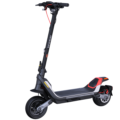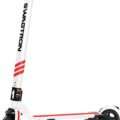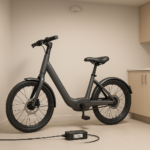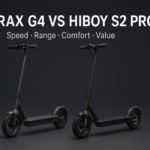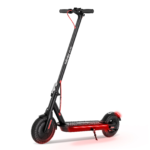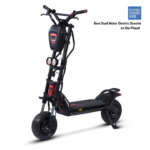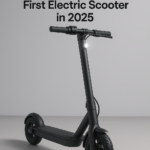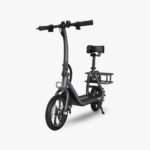- Home
- Scooters
- Electric Scooters
- Segway Ninebot F2 Pro
Segway Ninebot F2 Pro
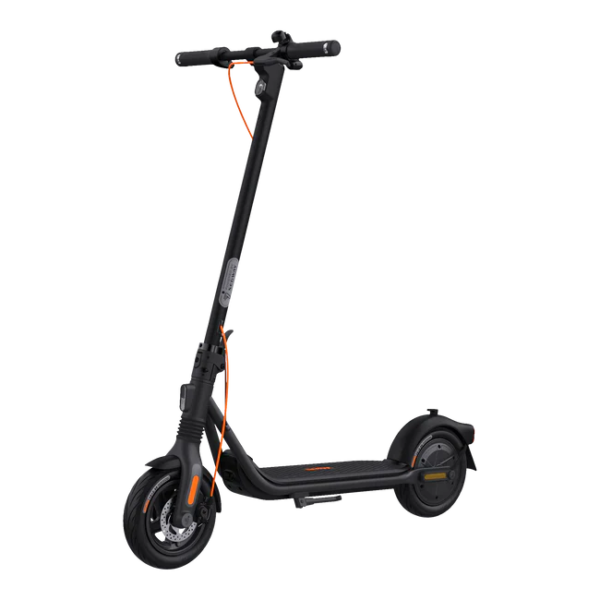



- Battery Range: 55 km
- Top Speed: 25 km/h
- Motor Power: 450 W nominal
- Weight Capacity: 120 kg (265 lb)
- Charging Time: 8 hours
- Scooter Weight & Portability: 18.5 kg (40.8 lb)
PROS
- Front suspension plus wide, self-sealing 10″ tyres improve comfort
- 900 W max output with 22% rated climbs; stable at city speeds
- Integrated indicators, TCS, and electronic horn boost safety
- 460 Wh battery with realistic range for mixed commutes
- App ecosystem with Apple Find My and customizable modes
CONS
- EU units cap speed at 25 km/h; cruise control often unavailable
- Heavier than the base F2; still not a hill-climb specialist
- No rear suspension; very rough streets still feel rough
- Charge time (~8 h) is longer than smaller-pack scooters





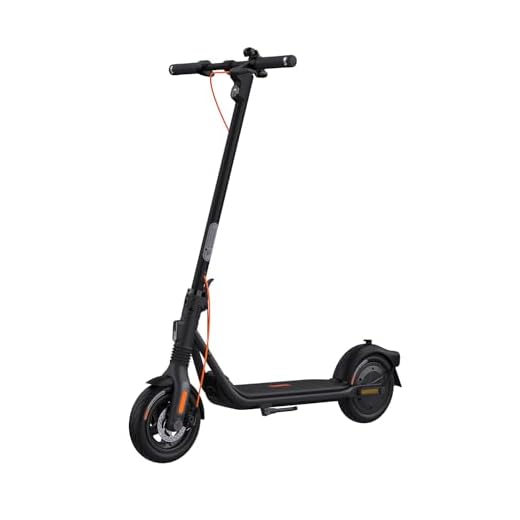
What the F2 Pro adds over the F2
The F2 Pro takes the F2’s city-friendly base and adds front suspension, stronger peak output, and an anti-theft electronic horn. These upgrades improve comfort on rougher streets and add confidence in dense traffic. Meanwhile, the deck, cockpit width, and overall geometry remain familiar, so the scooter still feels simple and predictable. If you liked the F2’s manners but wanted more bump compliance and a touch more punch, the Pro is the natural step.
Battery and range that cover a full day
A 460 Wh pack pushes practical commuting range beyond short hops. On flat routes and steady speeds, you can complete multi-leg days without hunting outlets. Even at the EU speed cap, the scooter keeps enough reserve for detours. Because capacity is sensible rather than massive, charge times stay predictable. You can top up after work and still head out for a late errand without babysitting the plug.
Motor character: composed power, not drama
The Pro’s motor peaks at 900 W, yet the throttle map favors smooth delivery. Eco and Drive modes keep launches tame in crowds. Sport mode adds urgency without making the front end twitchy. Rear-wheel drive also helps traction on dusty paint or damp patches. As a result, pulling away from lights feels controlled, and mid-corner adjustments don’t unsettle the chassis.
Speed, stability, and city flow
City flow typically sits between 20–25 km/h, which is exactly the Pro’s comfort zone in EU trim. The longer cockpit and wider bars help it track straight without constant micro-corrections. Side gusts and seam-ridden tarmac don’t shake it off line. Consequently, hands stay relaxed, shoulders stay loose, and focus stays on traffic cues rather than wrestling the steering.
Front suspension that earns its keep
The front spring suspension adds real relief over expansion joints, cracked curbs, and rough patches. It won’t turn cobblestones into velvet, yet it takes the edge off impacts that would otherwise jolt knees and wrists. Because the scooter still uses larger-volume 10-inch tyres, suspension and tyre compliance work together. Keep pressures in spec and the ride remains composed without bouncing.
Braking and visibility upgrades
A dual system—front disc plus rear regen—delivers predictable stops in dry and wet conditions. Lever feel is linear, and regen adds steady drag while harvesting a bit of energy. For signaling, the Pro builds in front and rear indicators with wide viewing angles. At night or in winter twilight, those electronic cues reduce ambiguity far better than hand signals. The high-decibel electronic horn cuts through noise when you need to be heard.
Traction control and smart app touches
Segway’s TCS fine-tunes rear-wheel behavior on slick surfaces. It doesn’t replace sound technique, but it helps on wet leaves and painted lines. In the app, you can adjust acceleration behavior, set speed caps, apply firmware updates, and lock the motor. Apple Find My support adds location awareness when you can’t remember where you parked. Together, these features reduce friction without demanding daily tinkering.
Portability: stronger, still manageable
Despite the suspension, the F2 Pro keeps weight reasonable at about 18.5 kg. The fold is quick and positive, and the footprint tucks under desks or beside café tables. Carrying up a flight is manageable, and rolling through stations is easy. Because mass sits close to the body when lifted, wrists feel less strain than with front-heavy designs. For mixed bike-rail commutes, that matters more than raw numbers.
Daily upkeep and long-term durability
Ownership should feel light. Check tyre pressure weekly, give the lever a quick squeeze to confirm consistent travel, and inspect the latch monthly. The sealed brake and tubeless self-sealing tyres reduce fiddly maintenance and flats. Hardware resists micro-loosening, but periodic checks are still smart. Over months, durability shows up as an absence of drama: quiet stems, steady tracking, and a deck that still grips when wet.
Weather etiquette and seasonal tips
IPX5 body sealing keeps drizzle from turning into downtime, yet judgment still rules. Slow earlier on slick surfaces, brake sooner, and avoid aggressive lean on paint. Expect range dips in cold weather; plan a slightly earlier charge and consider Drive mode. As temperatures swing, adjust tyre pressure—just a few PSI changes comfort, grip, and efficiency.
Who should pick the F2 Pro
Choose the Pro if you like the F2’s simplicity but need more comfort on broken pavement or want stronger hill starts. Riders covering 15–35 km per day with varied surfaces will appreciate the suspension and wider tyres. If you seldom meet rough streets and want the lightest feel, the base F2 or F2 Plus may be enough. If you need long-range, bigger-motor performance, a MAX-class model fits better.
Where it isn’t the right tool
The Pro isn’t a sport rocket or a hill-climb specialist. Long, steep grades will slow it, and riders seeking 30+ km/h cruising in EU regions will be limited by regulations. If daily routes are mostly pristine and flat, suspension adds less value. Match the scooter to your roads, your storage, and your willingness to carry weight—then buy once and be happy.
Final verdict
The Segway Ninebot F2 Pro adds meaningful comfort and safety to an already capable commuter. Front suspension, stronger peak power, integrated indicators, TCS, and an electronic horn raise confidence without raising complexity. It rides predictably, signals clearly, folds fast, and charges on a sensible schedule. For many mixed-surface city routes, that balance is exactly what commuting needs.
Specifications
General
| Model The Model specifies the exact version or name of the scooter. It helps identify its unique design, features, and specifications within the manufacturer’s product line. Knowing the model makes it easier to compare options, find compatible accessories, or look up support information. | Ninebot F2 Pro (EU “F2 Pro E”) |
| Brand The Brand identifies the manufacturer or company that designs and produces the scooter. A trusted brand is a sign of quality, reliability, and good customer support. Well-known brands often have higher standards for safety, performance, and after-sales service, giving you more confidence in your purchase. | Segway |
| Release Date The Release Date indicates when the scooter model was officially launched on the market. This helps you know how current the design, technology, and features are. A newer release date often means updated components, improved performance, and the latest safety or smart features. | 01 January 2023 |
| Recommended Age Recommended Age indicates the minimum age range that the scooter is designed for, based on safety, size, and ease of use. Following the recommended age helps ensure that riders can handle the scooter’s speed, weight, and controls comfortably and safely. Always check local laws and use protective gear, especially for younger riders. | 16+ (manufacturer guidance) |
Performance & Power
| Motor Power (Wattage) What it means: The motor power, measured in watts (W), shows how strong the scooter’s electric motor is. Why it matters: Higher wattage usually means better acceleration, more torque, and improved performance on hills or rough terrain. For example, a 250W motor is good for flat city roads and light riders, while a 500W or 1000W motor provides more power for faster speeds or climbing steep inclines. | 450 W nominal, 900 W max output |
| Top Speed The Top Speed indicates the maximum speed that the scooter can reach under optimal conditions. It’s usually measured on level ground with a fully charged battery and an average rider weight. A higher top speed allows you to travel longer distances faster, but always ensure you ride within legal speed limits and your personal comfort zone for safety. | 25 km/h (EU spec); up to 20 mph on some regional pages |
| Battery Capacity Battery Capacity refers to the total amount of energy the scooter’s battery can store, usually measured in ampere-hours (Ah) or watt-hours (Wh). A higher battery capacity means you can ride longer distances on a single charge, reducing the need for frequent recharging. Keep in mind that actual range can vary depending on rider weight, terrain, speed, and weather conditions. | 460 Wh (36 V) |
| Estimated Range per Charge The Estimated Range per Charge indicates the average distance the scooter can travel on a single full battery charge. This range is calculated under optimal conditions, such as flat terrain, moderate speed, and average rider weight. Real-world range may vary depending on riding style, terrain, weather, and load. A longer range means fewer recharges and greater freedom for longer trips. | Up to 55 km theoretical; ~40 km at max speed (test method defined by Segway) |
| Hill Climb Ability Hill Climb Ability describes the maximum incline or slope that the scooter can handle while maintaining stable performance. It’s typically expressed as a percentage or in degrees. A higher hill climb rating means the scooter can tackle steeper hills without losing too much speed or power. Actual climbing performance may vary based on rider weight, battery charge, and terrain conditions. | up to 22% grade |
| Drive System The Drive System refers to how power from the motor is delivered to the wheels. Electric scooters typically use either a hub motor (directly integrated into the wheel) or a chain/belt drive system. A high-quality drive system ensures smooth acceleration, efficient power transfer, and low maintenance. The choice of drive system affects performance, noise level, and overall ride experience. | Rear-wheel hub motor (RWD) |
Charging & Electrical
| Charging Time Charging Time indicates how long it takes to fully recharge the scooter’s battery from empty to 100% using the standard charger provided. Faster charging means less downtime and more time on the road. Actual charging time may vary slightly depending on battery capacity, charger output, and environmental conditions. | ≈8 hours from low state of charge |
| Battery Type Battery Type refers to the specific technology used in the scooter’s battery, which affects performance, lifespan, weight, and charging time. Most modern electric scooters use high-quality lithium-ion (Li-ion) batteries because they offer a good balance of energy density, durability, and low maintenance. A reliable battery type ensures consistent power delivery and longer riding ranges. | Lithium-ion 36 V with Smart BMS protections |
| Removable Battery A Removable Battery means the battery pack can be easily detached from the scooter for convenient charging and replacement. This feature allows you to charge the battery separately, swap it with a spare for extended range, or securely store it indoors in extreme weather. Removable batteries add flexibility and make it easier to keep your scooter powered up wherever you are. | No |
| Regenerative Braking Regenerative Braking is an energy-saving feature that converts some of the energy normally lost during braking back into battery power. When you slow down or brake, the motor works in reverse to generate electricity, which helps extend the scooter’s range and improves overall efficiency. This system also reduces wear on traditional brake components, leading to lower maintenance over time. | Yes |
| Lighting Lighting refers to the built-in front and rear lights that enhance visibility and safety when riding in low-light conditions or at night. Good lighting helps you see the road ahead and ensures that other road users can see you. Many scooters include LED headlights, taillights, and sometimes brake lights or side reflectors for added safety and compliance with local traffic regulations. | 2.1 W front LED headlight, rear/brake light; integrated front & rear indicators; E-mark reflectors (EU) |
Build & Dimensions
| Scooter Weight Scooter Weight refers to the total weight of the scooter when fully assembled, including the battery. This affects how easy it is to carry, lift, and store the scooter when not in use. A lighter scooter is more portable and convenient for commuting, especially if you need to carry it upstairs or onto public transport. Keep in mind that a sturdy frame and quality components may add to the weight but also contribute to better durability and ride stability. | 18.5 kg (40.8 lb) |
| Maximum Rider Weight Maximum Rider Weight indicates the highest rider weight that the scooter is designed to safely support while maintaining optimal performance and stability. Staying within this limit helps ensure reliable acceleration, braking, and climbing ability, and it protects the frame, suspension, and motor from excessive strain. Exceeding the recommended limit may reduce performance and increase wear on components. | 120 kg (265 lb) |
| Deck Size Deck Size refers to the dimensions of the scooter’s standing platform. A wider and longer deck provides more foot space, allowing you to stand comfortably and adjust your stance while riding. A well-sized deck improves balance and stability, especially on longer rides or at higher speeds. Compact decks, on the other hand, help keep the scooter lightweight and portable. | Not officially specified (F2 series long, wide, grippy deck) |
| Handlebar Height Handlebar Height refers to the distance from the deck to the handlebars, which affects your riding posture and comfort. An appropriate handlebar height helps you maintain good balance, reduces strain on your back and arms, and makes steering more comfortable. Some scooters have adjustable handlebars to fit riders of different heights, while others have a fixed height for a streamlined design. | 1252 mm overall height (unfolded) |
| Folding Mechanism The Folding Mechanism describes how easily and securely the scooter can be folded for carrying and storage. A well-designed folding system lets you quickly collapse the scooter into a compact size, making it convenient to transport on public transit, store under a desk, or fit into a car trunk. Look for sturdy latches and safety locks to ensure the scooter stays firmly in place when folded or unfolded. | Yes |
| Dimensions Folded Dimensions indicate the size of the scooter when it’s fully folded. This measurement shows how much space the scooter will take up when stored or carried, making it easier to check if it will fit in your car trunk, under a desk, or in a closet. Compact folded dimensions are ideal for commuters who need to bring their scooter on public transport or store it in tight spaces. | 1158.5 × 570 × 529 mm; Unfolded: 1158.5 × 570 × 1252 mm |
| Material Material refers to the primary construction materials used for the scooter’s frame and key components. High-quality materials like aircraft-grade aluminum, reinforced steel, or durable composites provide strength, stability, and a lighter overall weight. A sturdy material ensures the scooter can handle daily wear and tear while maintaining safety and performance. | High-strength steel frame (series messaging) |
Safety & Control
| Brake Type(s) Brake Type(s) describe the braking systems the scooter uses to help you slow down or stop safely. Common brake types include mechanical brakes (like drum or disc brakes), electronic brakes, and foot brakes. Many scooters combine multiple braking systems for added safety and shorter stopping distances. The type and quality of brakes affect your control, especially when riding at higher speeds or on slopes. | Front disc + rear electronic regenerative (dual braking) |
| Suspension Suspension refers to the system that absorbs shocks and vibrations while riding, providing a smoother and more comfortable ride over uneven or rough surfaces. Scooters may have front suspension, rear suspension, or dual suspension for better shock absorption and stability. Good suspension helps reduce rider fatigue and improves control, especially when riding on bumpy roads or off-road paths. | Front spring suspension (≈35 mm stroke) |
| Tire Type Tire Type refers to the kind of tires the scooter uses, which directly affects ride comfort, traction, and maintenance. Common types include solid (airless) tires, pneumatic (air-filled) tires, or hybrid options. Pneumatic tires offer better shock absorption and a smoother ride on rough surfaces, while solid tires are puncture-proof and require less upkeep. The right tire type helps ensure safe handling and a comfortable ride in different conditions. | Tubeless self-sealing pneumatic with jelly layer (≈58 mm width) |
| Tire Size Tire Size indicates the diameter and width of the scooter’s tires, which affect ride comfort, stability, and how well the scooter handles different terrains. Larger tires generally offer better shock absorption and a smoother ride over bumps and rough surfaces, while smaller tires keep the scooter lighter and more portable. Choosing the right tire size helps ensure a balance between agility and comfort. | 10-inch front & rear |
| Kickstand The Kickstand is a built-in stand that allows you to park your scooter upright when it’s not in use. A sturdy kickstand keeps the scooter stable and prevents it from tipping over, protecting it from scratches and damage. It also makes storing and accessing your scooter more convenient, whether you’re at home, work, or on the go. | Yes |
| Water Resistance Rating Water Resistance Rating indicates how well the scooter is protected against water and moisture, usually shown as an IP (Ingress Protection) rating. This rating helps you understand whether the scooter can handle light rain, splashes, or wet roads without damage. While most scooters are not fully waterproof, a good water resistance rating adds peace of mind when riding in changing weather conditions. Always avoid deep puddles or submerging the scooter to protect its electrical components. | IPX5 body; battery pack IPX6 (EU page) |
Features & Extras
| Display/Console The Display (or Console) shows important real-time information about your ride, helping you monitor your scooter’s status at a glance. Typical displays show speed, battery level, distance traveled, and riding mode. Some models also include additional features like Bluetooth connectivity, app integration, or backlighting for better visibility at night. A clear and easy-to-read display enhances safety and convenience on every trip. | Color LED dashboard (speed, battery, modes, BT, indicator icons) |
| Ride Modes Ride Modes refer to the different speed and power settings you can choose to match your riding style or road conditions. Common modes include eco for maximum range and energy efficiency, standard for everyday balance, and sport or turbo for higher speed and stronger acceleration. Switching between ride modes allows you to customize performance, conserve battery, and ride safely in various environments. | Eco / Drive / Sport + Walk; app-customizable acceleration/speed caps |
| Smart App Connectivity Smart App Connectivity lets you pair your scooter with a dedicated mobile app via Bluetooth. Using the app, you can monitor real-time ride stats like speed, battery level, and range, adjust settings such as ride modes or cruise control, lock the scooter for added security, and sometimes receive firmware updates. This feature adds convenience and allows you to personalize your riding experience right from your smartphone. | Segway–Ninebot App (lock, stats, firmware, TCS toggle) + Apple Find My support |
| Anti-Theft System The Anti-Theft System helps protect your scooter from unauthorized use or theft. This feature can include built-in alarms, electronic motor locks, GPS tracking, or remote locking through a mobile app. A good anti-theft system provides peace of mind when parking your scooter in public spaces, adding an extra layer of security to safeguard your investment. | Electronic horn and alarm, app motor lock |
| Cruise Control Cruise Control allows you to maintain a steady speed without continuously holding the throttle. This feature makes longer rides more comfortable by reducing hand fatigue and providing a smoother, more relaxed riding experience — especially on flat, open roads or bike lanes. For safety, cruise control can usually be easily activated or deactivated while riding. | Yes |
| Accessories Included Accessories Included lists the additional items that come with the scooter to enhance your riding experience and convenience. Common accessories may include a charger, kickstand, bell, lights, phone holder, or carrying strap. These extras add value by making your scooter safer, easier to use, and ready to ride straight out of the box. | Charger/cable, toolkit, user materials (typical package) |
Warranty & Compliance
| Warranty Period The Warranty Period indicates how long the manufacturer guarantees the scooter against defects in materials and workmanship under normal use. A good warranty provides peace of mind, showing the brand’s confidence in its product quality. Always check what parts are covered, such as the frame, battery, and motor, and follow the maintenance guidelines to keep your warranty valid. | EU messaging notes “45+ tests” and 2-year core components; retailer terms vary by country |
| Certifications Certifications confirm that the scooter meets specific safety, quality, and environmental standards set by recognized organizations or regulatory bodies. Common certifications may include CE, RoHS, UL, or other local compliance marks, depending on your region. These certifications ensure that the scooter is manufactured to high standards and is safe and legal to use in your country. | EU E-mark reflectors/indicators; Smart BMS safety protections; Apple Find My available after enabling via app. |
Price Comparison








